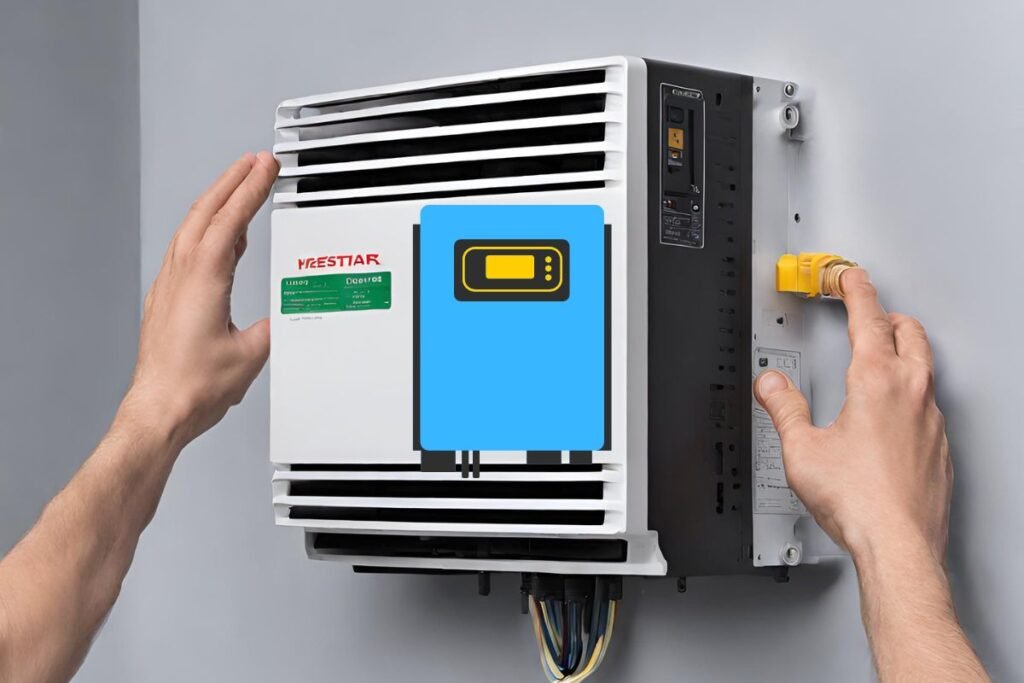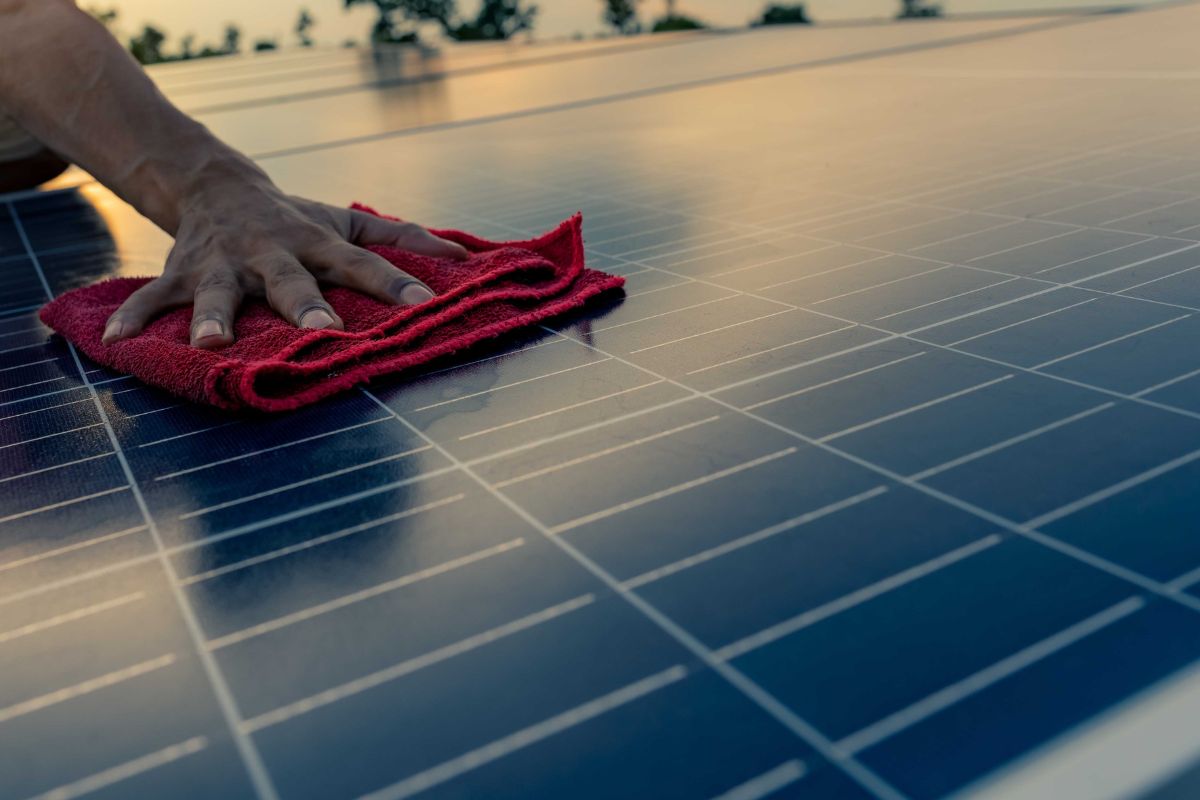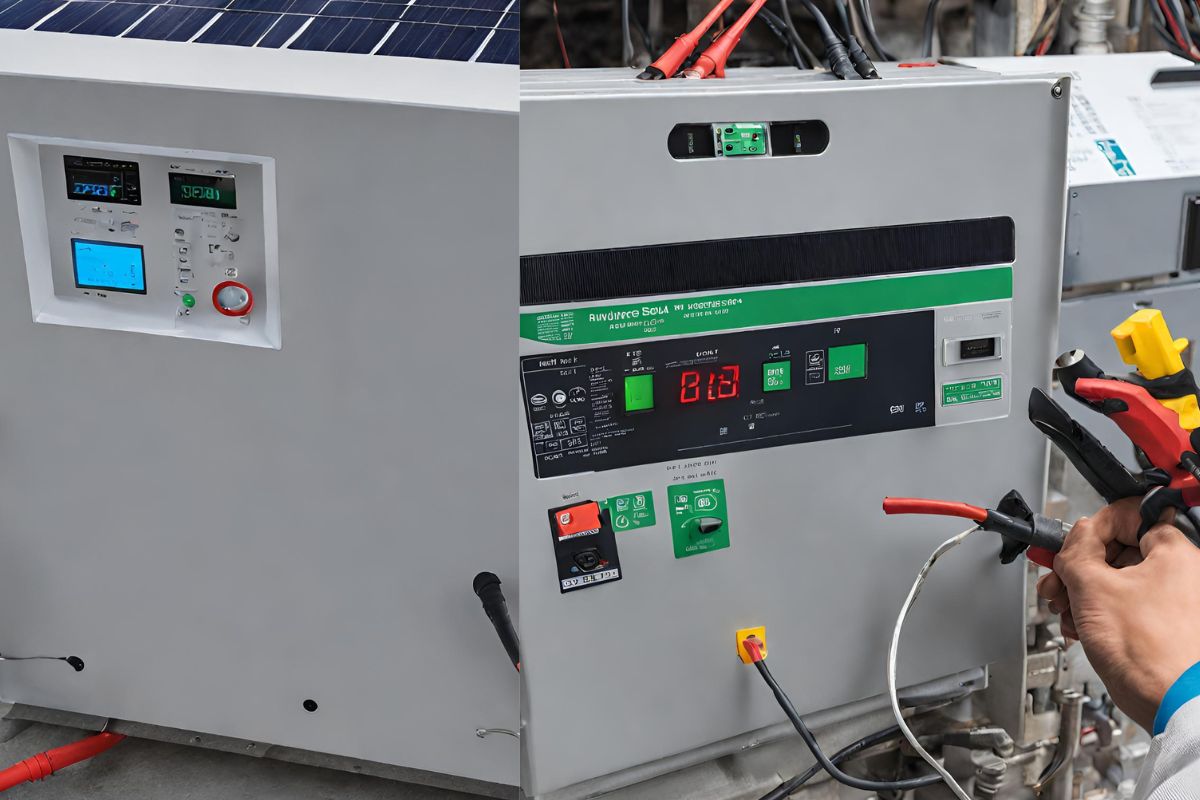To reset an inverter fault, in simple terms, is what is called “Power cycle the inverter”. To reset, disconnect it from the power source and turn it back on within 4 minutes.
However, you must take precautions while resetting the inverter fault.
Suppose there has been damage to the inverter or its parts. Trying a reset without addressing the root cause may pose risks.
And that was what happened to my aunt’s husband, who almost blew up every electronic in the house because of an underlying issue.
In this article, I will show you every step while trying to reset an inverter fault.
Let’s get started.
Read Also: How To Repair Solar Inverter.
How To Reset My Inverter
Inverters change DC electricity into AC electricity.
They are used for many things, like backup power for businesses and homes—green energy, and systems connected to the power grid.
A clear and often annoying beeping sound can happen when your inverter is overloaded.
Because current flows through constantly, every gadget will eventually break down. This can also happen for inverters when they get overloaded.
It has steps to reset the transformer overload so the gadget can work normally again and avoid damage.
Depending on the type of inverter. You may need to press a reset button or turn the device off and on again by hand to reset it to default, but there are steps to do that.
Let us get into the details.
Step to reset the inverter fault
Before you reset the inverter, ensure the problem isn’t caused by something outside.
Check the inverter’s wires, links, and other parts to ensure there aren’t any problems from the outside.
You can reset your inverter if it isn’t working right. It may help to reset the inverter to get rid of any minor issues and get the device back to how it was supposed to work.
If you want to reset your inverter, follow these steps.
First, find the button on your inverter that says “inverter reset.” Many inverters have a screen or control panel where you can change settings and fix problems.
Most of the time, you can find it on the front or back of the switch.
Hold the button for about three seconds, then let go and wait for the inverter to re-open.
The DC switch on the bottom of the inverter should be turned to the left if the inverter you are using doesn’t have a button that lets you restart it.
The inverter will no longer get power from the solar panels.
Turn off the sun switch in your cabinet of electrical items. After that, the converter stops working at all.
Set the solar fuse again, wait 25 seconds, and then turn the inverter DC switch to the right to turn it on.
On the other hand, using a converter or trying to fix faults without knowing what caused them could cause more problems. If you need help with something, it’s best to find an expert.
Read Also: How To Connect Solar Panel To Inverter Without Battery.
Why Has My Solar Inverter Stopped Working
Several factors could cause a solar inverter to stop working. The most common one I know is wiring problems, with loose connections or damaged cables.
Another one is when the inverter overheats due to inadequate ventilation or excessive sunlight exposure, which may trigger automatic shutdowns.
Let us look at some of the other factors that can cause the inverter to shutdown:
1. Energy grid failure.
Sometimes, when there is a power outage, the inverter regulator switch is turned off, preventing the inverter from receiving electricity from the grid.
The inverter will automatically turn off for safety because of the hindered electricity flow.
Another thing that prompts energy grid failure is the continual measurement of the voltage and frequency from the grid; the inverter saves the energy the panels create.
It then changes the amount of power that is generated by these measurements.
As a result, the inverter will turn off itself whenever there is insufficient electricity on the grid.
2. An inverter outage
When power production exceeds the normal demand, It can cause an inverter to shut down, which is required to transfer electricity back to the grid.
A solar inverter must apply voltages greater than the grid’s voltages to push back the power for it to be able to return the electricity.
Because inverters are restricted to 250V, the inverter will turn off if the grid voltages are too high and cannot surpass the voltage.
3. The lighting is off.
An inverter is attached to the solar panel sheets, generating electricity only via sunshine.
When the sun sets, fog is there, the rainy season occurs, or snow on the sun-fueled sheets, it is simple: the system will not supply enough electricity because the light path is disrupted.
As a result, no power is created, and the inverter will shut down.
Under typical circumstances, the inverter will begin operating once there is sufficient light to generate power.
There is a possibility that this illness will manifest itself throughout the winter months, on days that are cloudy and dim.
4. High voltage output when the battery is faulty.
There is a possibility that your inverter is operating well. Still, it is also possible that your battery has not been charged sufficiently, which has caused the inverter to shut down.
The high output voltages of the inverter cause the inverter to shut down many times, which can even happen multiple times.
To ensure the system’s safety, the inverter will automatically shut down.
5. When batteries are not properly connected.
The connections between a battery and an inverter may have become loose or linked inappropriately.
Depending on the time that the inverter has been operated, the battery terminals may have become eroded due to oxidation and carbon release, which causes the inverter to shut down.
Repairing And Troubleshooting Solar Inverter Faults
To troubleshoot a solar inverter error, you must first determine the source of the problem.
This can be accomplished by analyzing the inverter’s display panel for fault codes or warnings and visually inspecting it and its components.
Repairing common solar inverter faults
Once the source of the problem has been discovered, you may take the following actions to resolve it:
1. Overcurrent errors
Overcurrent fault can occur when the output current exceeds the overcurrent detection level, which is approximately 175% to 200%
They usually occur when the driving capacity of the motor is insufficient. The output motor wire has a loose connection or splice.
When an external device, such as a contractor, is present on the drive’s output and is not functioning correctly.
Also, if you have an issue with the encoder feedback, one or more parameter settings are wrong.
To troubleshoot, check the solar panels for any obvious damage or debris that might produce a short circuit in the event of an overcurrent issue.
If the panels are clear, an inverter repair professional must inspect the inverter’s DC input connections for loose or broken wires.
Electrical installations with safety systems such as fuses and circuit breakers can help prevent overcurrent.
These devices are chosen depending on the projected load and the circuit’s possible dangers.
Regular maintenance and inspections are also required to identify and repair any problems that might lead to overcurrent.
2. Overheating errors
High ambient temperatures, for example, in desert settings, can exceed 49°C, considerably increasing the danger of inverters, which can lead to overheating.
Inverter exposure to direct sunlight without shade can result in high interior temperatures caused by solar radiation.
Dust and debris can also build in agricultural and industrial locations, decreasing ventilation and heat dissipation.
In the case of an overheating malfunction, inspect the inverter’s ventilation system for debris or obstructions.
If the ventilation system is in good working order, a solar repairer will be required to evaluate the inside components of the inverter for signs of damage or malfunction.
You can do a few things to keep your solar inverter from overheating by storing the inverter in a cool, well-ventilated area.
Ensure the system is properly installed and all connections are tight and secure. In addition, the system should be checked regularly.
3. Undervoltage errors
In the event of an undervoltage problem. An inverter repairer will need to examine the battery and, if necessary, replace it; it’s as simple as that.
Low intermediate circuit DC voltage is to blame. A blown fuse, a broken isolator, an internal rectifier bridge malfunction, or a low mains voltage can cause it.
Most of the time, you should check your power supply and fuses.
Check the operation of the isolator, contactor, and the incoming voltage to see whether it is too low.
They evaluate the connections on the panel to ensure they are secure and not broken if the battery is in excellent condition.
4. Islanding errors
Islanding error means that the AC voltage grid voltage is reading 0 V at some point in the inverter, which may not be a fault with the inverter.
This might be due to a faulty tripped or failing circuit breaker. It’s also possible that there’s a short circuit somewhere in the inverter.
The end user might check the circuit breaker, but a solar installation may need to test for a short AC circuit before the inverter’s AC connection or by measuring the voltage across the AC terminals.
Choosing the correct grid tie inverter connection is critical with today’s complicated wind energy storage systems that employ an inverter.
Safe and dependable electricity is more likely with an anti-islanding inverter linked to the grid.
The most effective way ahead for power distribution is to use active anti-islanding solutions that connect wind turbines to grid tie inverters.
A solar repair professional will inspect the inverter’s connections to the grid to verify that they are secure and not harmed in the event of an islanding fault.
They may also need to verify the inverter’s settings to ensure it is appropriately designed to detect islanding.
Read Also: How To Repair Solar Inverter.
Final Thought
We have seen what resetting the inverter fault is all about. We have also noticed that many inverters have a control panel where you can access settings and clear faults.
It is simply by navigating through the menus to find the fault history or error log. You will see an option to clear faults or reset the inverter from the control panel display.
However, many inverters have a different preface, and you can also read their manual for more details.
Read Also: Why Solar Inverter Not Working Properly.



